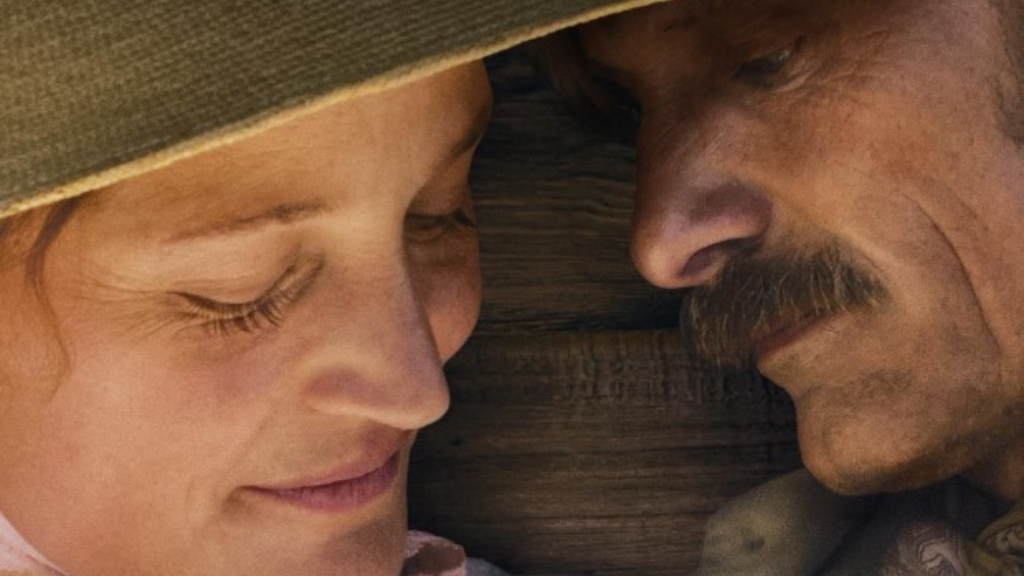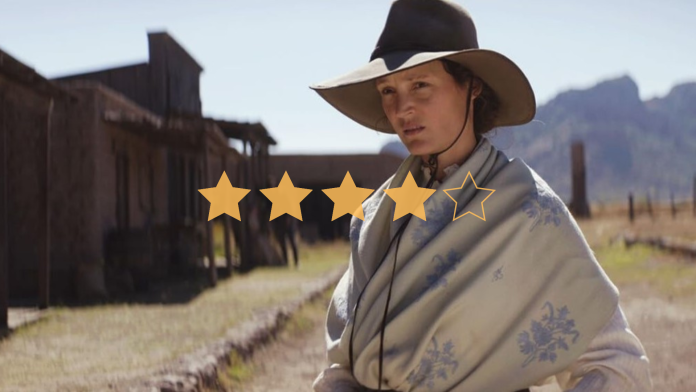Though corruption is rife in the plot of The Dead Don’t Hurt (2023), it’s a relatively sedate western, in contrary to the genre and more akin to the anomaly Unforgiven (1992). Violence isn’t in abundance, allowing us to focus on Vivienne’s journey in all its uniqueness. A thoughtful delve into the western genre, Viggo Mortensen doesn’t completely abandon tropes in what is his second journey in writing and editing, but showcases that violence and cowboys isn’t all a western can be.
★★★★☆
Though The Dead Don’t Hurt may have a plot rife with underlying corruption and an impending death as its main focus, ultimately, it’s a story of one (or better said, two people) carrying on with love and life despite overwhelming circumstances. The film opens with a murder spree at a saloon, flipping to Holger Olsen (Viggo Mortensen), or best known by his beloved as Olso, burying a woman we quickly find out to be his late partner, Vivienne (Vicky Krieps). A perpetrator is found, though by all paying close attention, he isn’t the culprit, looking unlike the killer seen minutes before. Corruption establishes itself as underpinning the story as the mayor confirms the guilty verdict and hangs the wrongly convicted townsman. From this point on, a disjointed narrative unfolds, primarily tracking Vivienne (Vicky Krieps) in the 1860s as she comes to settle in Nevada.
Krieps artfully showcases the hopeful perseverance that encompasses Vivienne throughout the isolation and turmoil of some of the narrative. Like very few stories before it, the film focuses on those left behind (in this case, Vivienne as Holger leaves to fight in the Civil War), and Krieps embodies a woman fighting against the constraints of society in the subtlest of ways. Though in some moments few words are necessary to keep the story moving, it’s this ability to play a range of emotions without words that makes Krieps’ performance so powerful. With glimpses at her childhood and the recurring motif of an anonymous Knight, mimicking her hero Joan of Arc, Vivienne is easy to build a connection with. And despite there being only one fully-realised female character in the story, Vivienne’s isolation, plights, and perseverance highlights the struggle of many women in the 19th century and do it justice.
Indeed, performance isn’t the only aspect of the film to shine. The characters’ backstories offer more depth that keeps you invested in the narrative; Vivienne and Holger discussing their emigration to the Americas sets a different scene than those before with nuances that make their story fresh amid countless tellings of the Wild West. Krieps’ performance of Vivienne, in her open and determined portrayal, fuels the story. She takes what could simply be an ode to nature and a story of suffering and instead weaves it into a story of hope and connection.

A character in its own right, the natural landscape shines in this narrative in the wild west. Ontario and Mexico stand in for Nevada to curate an idyllic, peaceful spot for Vivienne and Holger’s home. Complimenting the natural landscape, the film embraces the use of natural sound with violin blends. But despite the serenity crafted, it is the isolation amid nature that becomes a threat to Vivienne for the exact same reasons Holger sought the place. Regardless, the musical and shooting choices together feel masterful, moving the story along and allowing moments of peace in others.
Unsurprisingly with such emotion in the film, the pacing is slow in places. Those slower narrative moments ensure an appreciation of the cinematography and the natural landscape—particularly those warm, orange hues and symmetrical shots. Mortensen offers up the look of an arthouse film in this western package, but the non-linear chronology ensures the film doesn’t falter in keeping you focused—you are fully invested in the unravelling of events.
Through all the calmness and compatibility formed in Mortensen’s and Krieps’ performance and romance, Weston (played by Solly McLeod) is able to pack a larger punch with his villainy. With some cliché lines and darker clothes, McLeod brings what could be a caricature of a villain to life. Complimenting McLeod’s more overt evil is Danny Hudson as the mayor, Rudolph Schiller, and Garret Dillahunt as Weston’s father, Alfred, an investor in the town. With this small grouping, The Dead Don’t Hurt sticks to intimacy and subtlety over the big shoot-outs expected.

The Verdict
Both a tragic love story and a nuanced depiction of the conflict between revenge and forgiveness, The Dead Don’t Hurt is a portrait of a passionate woman determined to stand up for herself in an unforgiving world dominated by ruthless men and complemented by a nuanced performance by Viggo Mortensen and a character in and of itself, Ontaria, which stands in for Nevada. The Dead Don’t Hurt stands out for delving past the expectations of a western. Through the slow pacing and sometimes confusing chronology, the film does occasionally lose focus, but ultimately the performances and continual bid to showcase struggle and connection makes The Dead Don’t Hurt a moving cinematic spectacle regardless—a different kind of a story painting a portrait of an ordinary woman.
Words by Annabel Smith
Support the Indiependent
We’re trying to raise £200 a month to help cover our operational costs. This includes our ‘Writer of the month’ awards, where we recognise the amazing work produced by our contributor team. If you’ve enjoyed reading our site, we’d really appreciate it if you could donate to The Indiependent. Whether you can give £1 or £10, you’d be making a huge difference to our small team.
